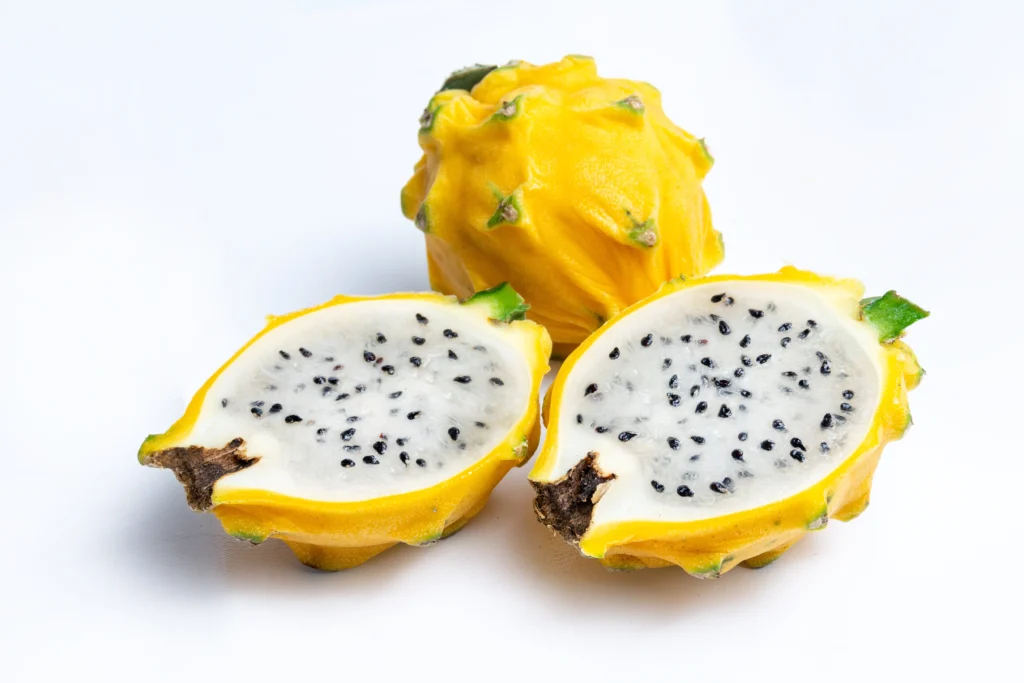Pitahaya (in the Antillean language, “scaly fruit”) or dragon fruit are names of the fruits of various species of the Selenicereus genus of the Cactaceae family, originating in America, especially the United States, Mexico, Colombia, Ecuador, Costa Rica and some other Central American countries,12 although its production has expanded to other regions of the world, especially Qatar, Saudi Arabia, etc.
Description
The pitahaya is a cactus plant, and as such, resistant to drought. The plant is a succulent, rustic cactus with long, triangular stems. It usually entangles itself on nearby trees, feeding on the moisture from their bark and climbs up the branches eight or ten meters from the ground without penetrating the soil. The pitahaya flower, which is tubular, hermaphrodite like most cacti, is beautiful but brief, as it appears dazzling in the morning and as it begins to feel the heat of the sun it suddenly dehydrates. It opens only once at night and its penetrating aroma attracts numerous insects. It is self-pollinated but can also cross-pollinate, with bats being the best pollinators in its natural environment. The formation of the fruit from pollination to harvesting takes four to eight months depending on the existing temperatures.
The fruit is ovoid in shape, 10 cm long by 6 cm wide and is usually green from birth, which turns yellow or red depending on the cultivar as it develops, offering a scaly skin from whose special characteristic arose its name “pitahaya”, which in Haitian means scaly fruit. This skin has groups of hard and sharp spines that come off easily, and must be carefully removed before harvesting the fruit to avoid punctures. It is a tasty fruit that contains a soft, sweet and tender pulp in the yellow cultivars and crimson in the red-skinned varieties, which usually contain less sugar.3
Species
There are two main species: Selenicereus triangularis (yellow pitahaya) and S. ocamponis (red pitahaya). The one that produces red fruits is much more attractive but has the disadvantage of being much more fragile and delicate, withstanding transport and subsequent marketing poorly. The yellow one is less perishable and offers better commercial possibilities due to its resistant qualities and, above all, its flavor, superior to the red varieties.3 There are other species, such as the following:
Selenicereus costaricensis, with red pulp and pink skin
Selenicereus monacanthus, with red pulp and pink skin
Selenicereus undatus, or “queen of the night”, with white pulp and pink skin
Properties
The peel is purplish green or yellow. The pulp of the pitahaya contains small black seeds. Its aroma is lost when heated. Red pitahayas have white or red pulp; those with red pulp are more difficult to grow and therefore less common, although their flavour is more intense than those with white pulp.
Pitahaya with pulp
Pitahaya with exposed pulp to appreciate the soft but firm texture.
They are fruits sensitive to pressure and therefore difficult to transport. In Europe it is possible to find it in supermarkets; those from Central America between July and December and those from Vietnam between January and June. Fruits from Thailand arrive by plane throughout the year.
Pitahaya helps in the creation of red blood cells. 90% of the fruit is composed of water and is rich in iron, calcium and phosphorus; it also contains vitamins B, C and E. It is rich in fibre which helps intestinal transit. Its energy value is 210 kJ/100 g.

